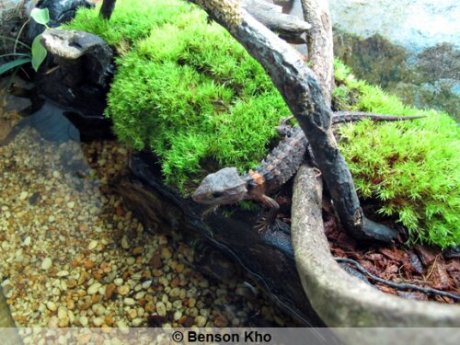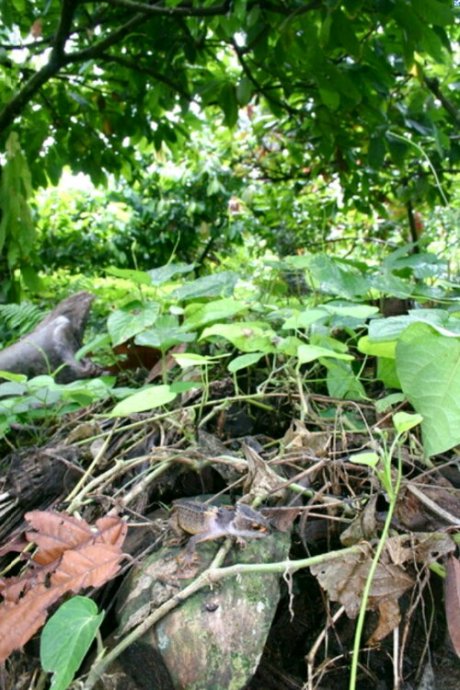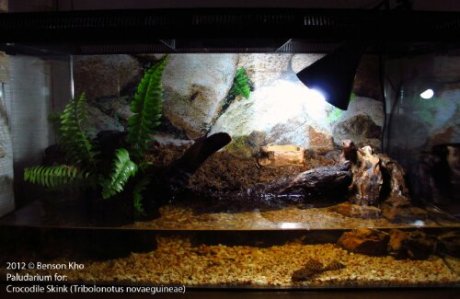Crocodile Skinks
Tribolonotus spp (Dumeril and Babron 1839)

Tribolonotus novaeguineae (Schlegel, 1834), stockier in appearance and scarcer in the market compared to T. Gracilis
Distribution: Tribolonotus gracilis and Tribolonotus novaeguineae are restricted to New Guinea, while the remaining six species range throughout Indonesia, New Britain, Manus and the Solomon Islands (McCoy, 1980; O’Shea, 1991, 1994).
Habitat: Generally found under vegetation in the immediate vicinity of water (Greer and Parker, 1968; O’Shea, 1991, 1994; Rogner, 1997) and Coconut plantations.
I love the prehistoric look of this fascinating lizard! Its heavily armoured body combine with it’s ability to swim and vocalize makes it one of my favorite. The four rows of enlarged, pointed and ridged bony scales resembles crocodiles and thus explains their common name.
Housing: Maintaining a healthy and happy Tribolonotus is relatively easy if the correct housing specifications are met. They require high humidity level of at least 75-80%. To maintain this humidity level yet provide good ventilation, I house my Tribolonotus in a paludarium – a vivarium that incorporates both terrestrial and aquatic elements, something similar to its natural habitat. For substrate I use coco husk and forest moss by Exo-Terra, and are place separated from water by a false bottom so that they are not soaking wet but remain humid. This method allows for life moss to be planted on top of the substrate to create a natural appearance. I allow one side of the land area to be dryer so my Tribolonotus can choose where he wants to hang out. A driftwood is used as hide and real jungle vines are placed overhanging the water to allow for climbing. Hidden beneath land is my filtration system. It’s a simple powerhead setup with an inlet on the right and outlet at the far left of the tank to create one way water flow. For easy maintenance I use a nice piece of rock as its cover so it is accessible from above yet remain unnoticed. I keep a few Malayan shrimps for cleaning service and a few gold fish should my Tribolonotus need some snacks. Lastly, a 40 watt daylight lamp is used for my life plants and to regulate temperature.
They grow to an average size of 7.2-7.8 inches and weighs 38-45g.
Their lifespan is currently still unconfirmed but it could be anywhere from 10 to 15 years if properly kept.
Tribolonotus spp are secretive lizards that will easily become distressed if being handled too often. I rarely handle mine, only occasionally during maintenance. In my personal experience, they are not too shy to stay in the open once they have fully acclimated to their environment. My T. Novaeguineae stays out to watch TV with us as its paludarium is just opposite the television. He is also tame enough to feed from my hand. Their natural diet in the wild are mainly insects, but also includes worms, slugs and sometimes small mammals like young mice. In captivity, I feed mine crickets, mealworms, turkistan roaches and baby dubia roaches that are no wider than the tribolonotus’s head – all of which have been gut loaded and dusted with calcium powder+vitamin D3. Due to lack/non exposure to natural sunlight, vitamin D3 is important unless you use a good U.V.B full spectrum lamp.

Built on false bottom concept with one way water flow, complete with filtration system to maintain water quality.
The genus Tribolonotus includes 8 known species and two are commonly kept as pets; Tribolonotus gracilis – Red-eyed Crocodile Skink and Tribolonotus novaeguineae.
The rest are:
Tribolonotus annectens
Tribolonotus blanchardi
Tribolonotus brongersmai
Tribolonotus ponceleti
Tribolonotus pseudoponceleti
Tribolonotus schmidti

(Tribolonotus ponceleti), a very rare lizard of the Solomon Islands
Credit: MICHAEL MCCOY/SCIENCE PHOTO LIBRARY
So if you’re interested in keeping something a little bizarre, Tribolonotus spp is definitely worth adding to your collection.


